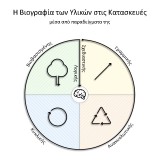Supervisor:
2024
The main topic of this research is about materials’ route in construction through four main design logics: the linear, the recycle, the circular and the bio-based logic. To be more specific, there are two problems that are mentioned firstly and that our era has been plagued by. These two problems are the environmental crisis and the increased production of waste, which have been deteriorated due to the linear development model. Furthermore, the relationship of the construction industry with these problems is investigated, as well as the responsibility of the architect. Then, the application of the linear, sustainable and circular models in design is analyzed, as well as their differences in the life cycle assessment in construction. In this way we understand clearly the materials’ route that is depending on the model they follow. Afterwards, a comparative study of examples is presented, which was based on seven categories – diagrams, inspired by the respectively diagrams of Peter van Asshe, which are included in the four main design logics that are mentioned. In addition, the analysis of the examples focuses both on the design strategies that are applied and on the characteristics of the construction and the materials. Regarding construction, for example, characteristics such as scale, means of production, adaptability and degree of assembly difficulty are studied. However, origin, wear, standardization and assembly methods are studied for materials. In this way, the specific approach is studied in more details, helping to draw conclusions about the materials’ route, the means used, the different approaches to design, the advantages and disadvantages of each logic, as well as the impact that each one has in the environment. Ending, the importance of interdisciplinarity and systematic and updatable education, as well as raising awareness of society, is emphasized in order to achieve a substantial change.
